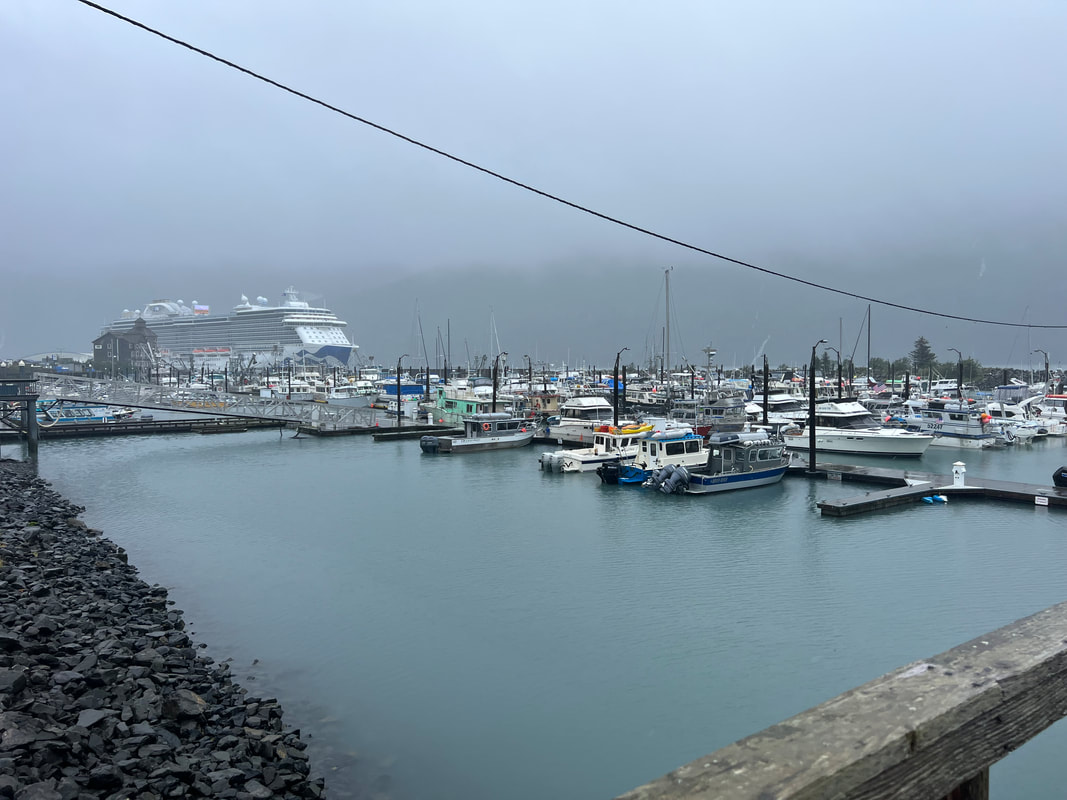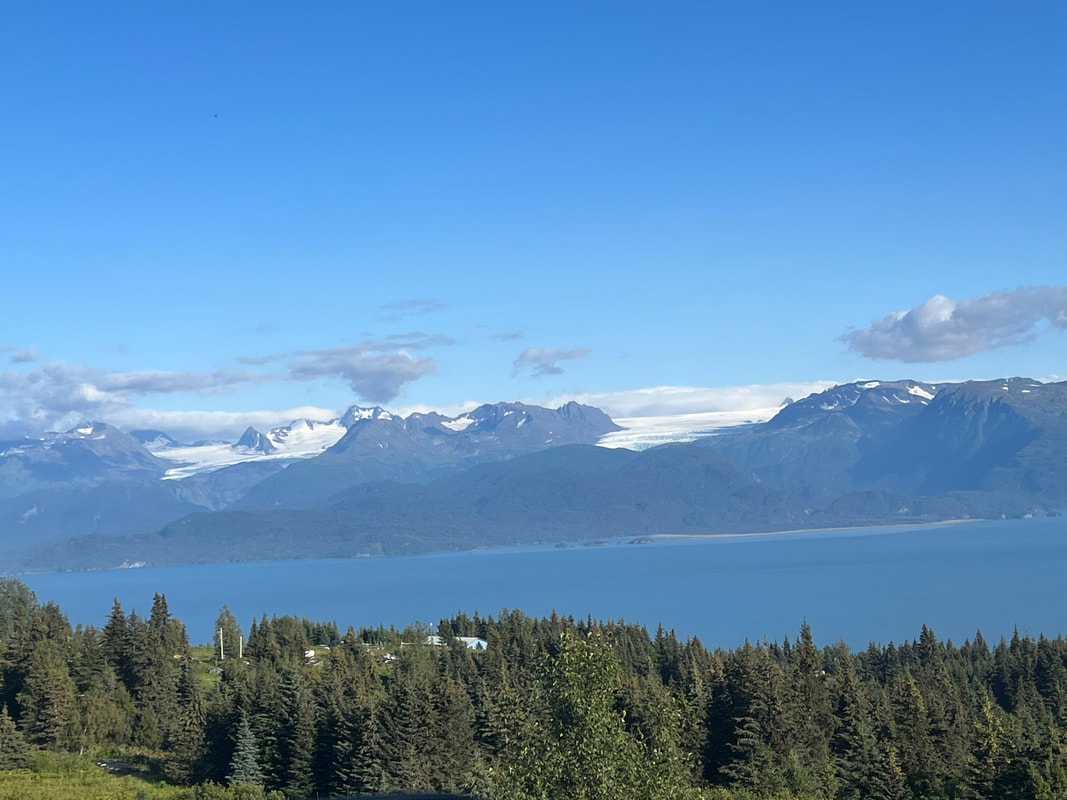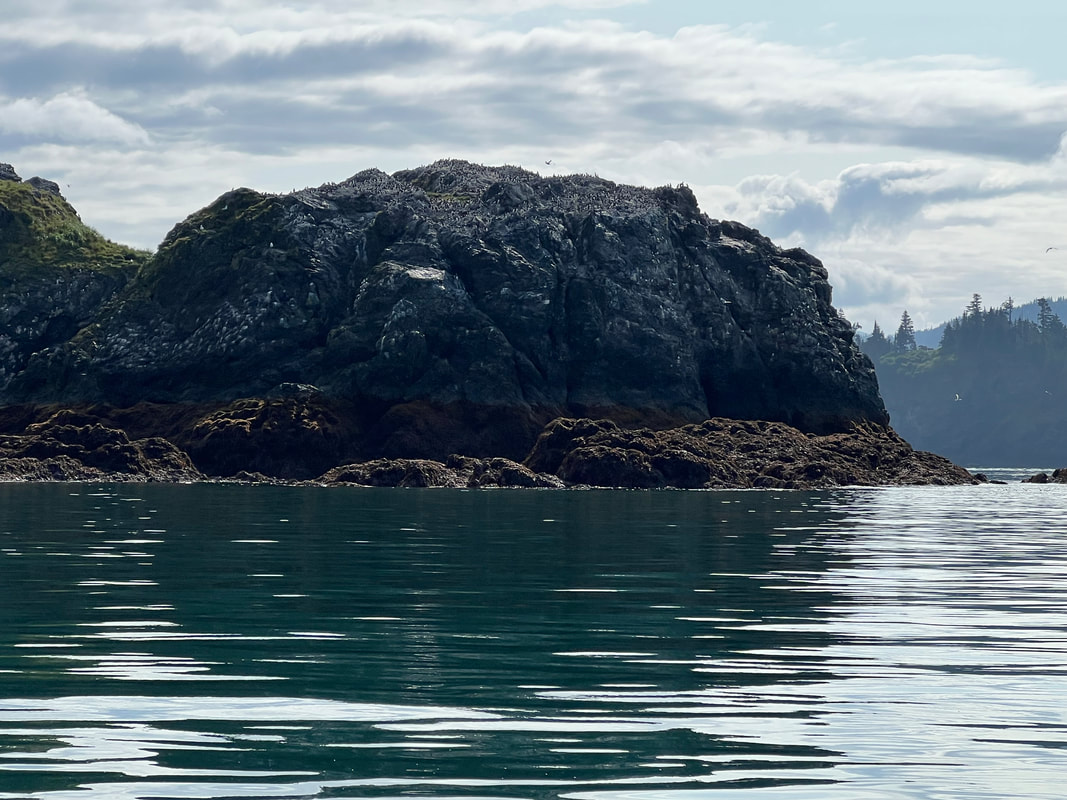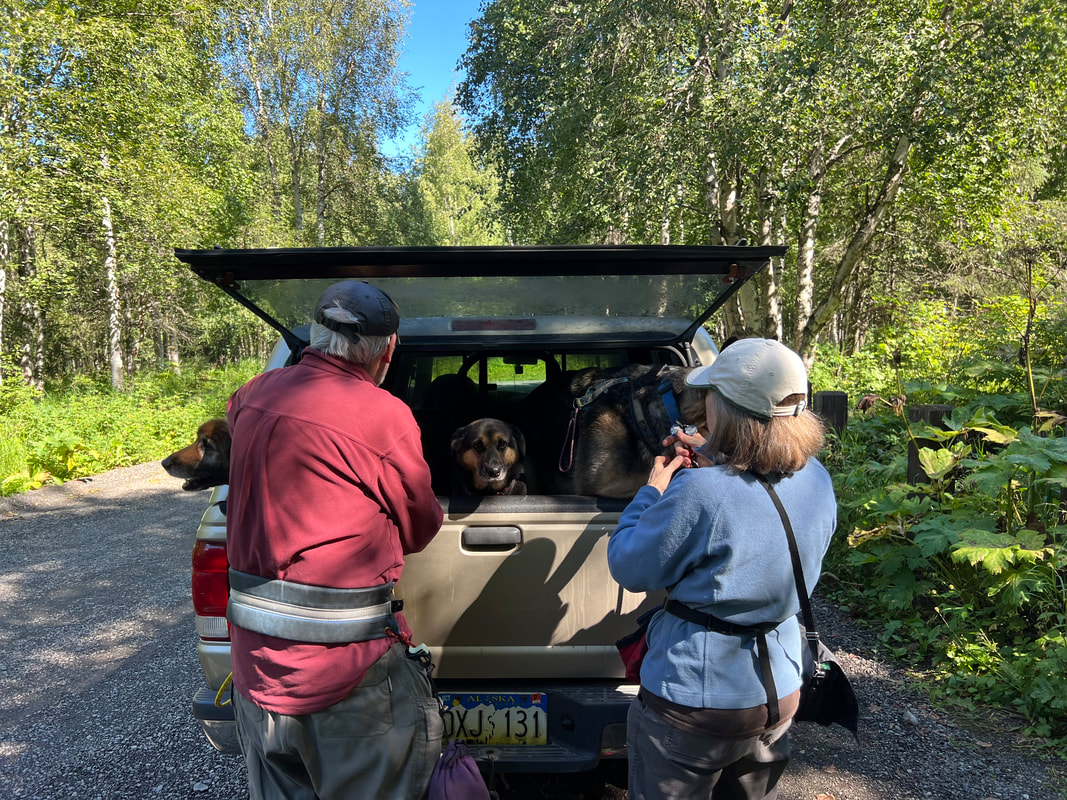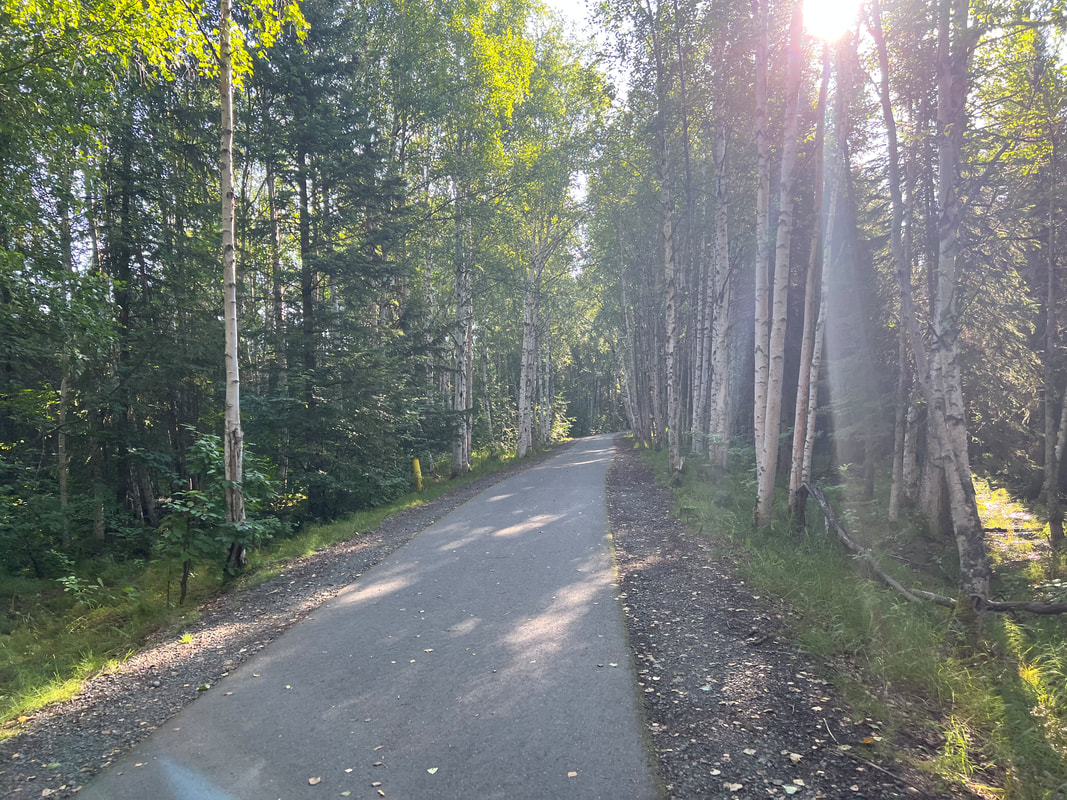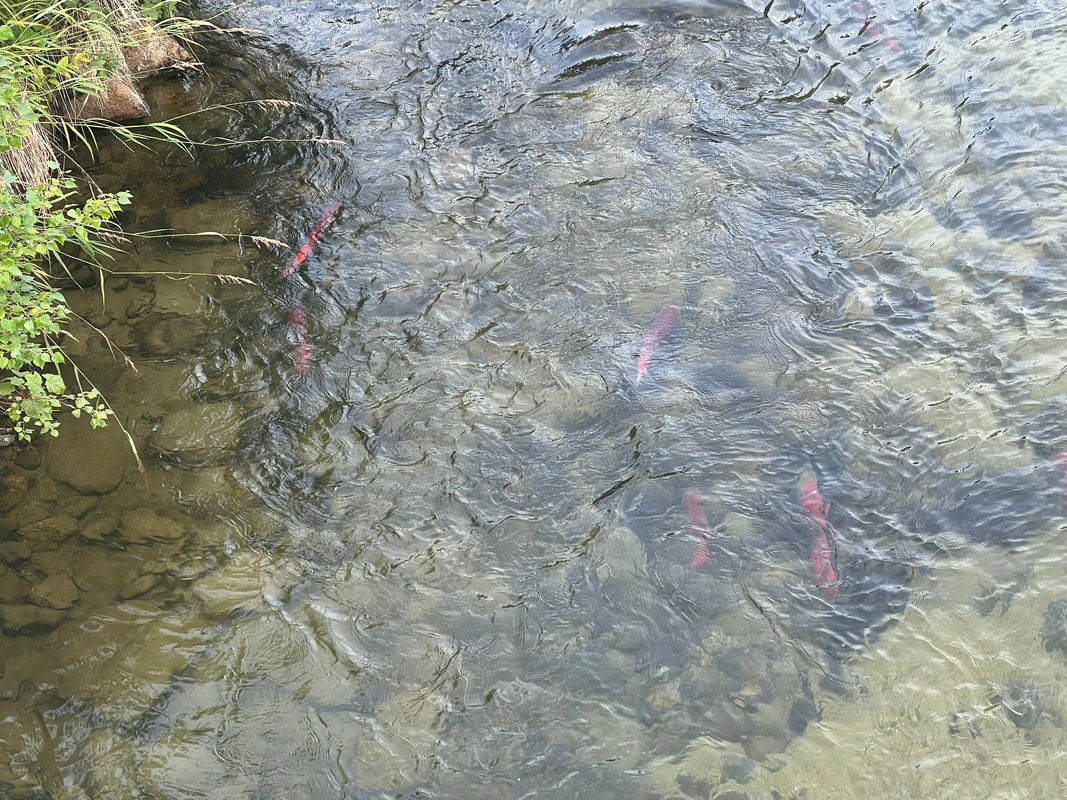|
We left the campsite and drove into Seward. We did a bunch of provisioning, Tom did some work, and we took a last walk around the city - and got another gelato and sorbet - before heading for Whittier. We found a very nice campsite on a small lake near the Portage Glacier before the tunnel, so we made plans to take a walk on the Trail of Blue Ice in the morning, and then head for Whittier to see the two buildings where everyone in the town lives in the winter. We listened to pouring rain all through the night, and it continued to rain as we got up and ate breakfast. We bagged the idea of taking a hike before going into Whittier, and packed up and headed for the tunnel. Whittier isn’t on the normal tourist track, but a number of people we’d talked to had asked us if we were planning to go to Whittier. We hadn’t been planning to do it, but after being repeatedly asked, and then asking other people, we were intrigued both by what we’d heard of Whittier, and by the odd look on most people’s faces when we discussed it. Whittier is weird for a number of reasons. The only way to get there by land is to go through a tunnel, which used to just be a railroad tunnel, but which they somewhere along the line decided to open up to cars. But, the tunnel is just one set of railroad tracks running through about two and a half miles of rock, so they let cars go one direction on the hour, and the other direction on the half hour, and everything stops once in a while for trains. Once you’re in Whittier, there’s not much there other than warehouses and boathouses, and a few buildings for tourists, although a lot of those are closed. We didn’t see any houses; instead, the entire town lives in two big condo buildings, which also house government offices and schools. One of the buildings is fairly new, but the other was built during WWII, and while it has been updated over the years, it still looks like it was built in the 1940s. There’s also another enormous building that used to be another central housing/living/working building when Whittier was a military base, but that building has been abandoned and just looms over the harbor with all of its windows broken, looking spooky. Everywhere you walk in the town, including on the docks, on the streets, and in the tunnels under the streets, there’s bear poop. We didn’t see any bears, but my overactive imagination vividly pictured the people and the bears coming out and mingling at night when all the tourists go home. It probably didn’t help that it seemed to rain harder and harder the whole time we were there, and fog was looming over everything, but all I could think was that if someone wants to get a feeling for a horror movie set, they should just hang out for a while in Whittier and soak up the vibe. By the end of the day, we thoroughly understood why the most frequent thing we heard about Whittier was “Whittier is weird.” We drove back through the tunnel and stopped at a small park where the salmon were running. What started as a short stop ended up being a fairly long walk because it was fascinating to watch the salmon making their way up the stream, and the whole stream was full of them. We also saw a lot of dead and chewed on salmon by the side of the stream, so we made a short detour back to the truck for our bear spray, although we didn’t see any bears. We went back to the same campsite for the next night, and although it continued to rain all night, we suited up and did the hike on the Trail of Blue Ice the next morning. We saw more salmon filled streams, although the most impressive thing was the sight and sound of the many waterfalls crashing down the mountains after all of the rain. What had looked like thin white lines a couple of days before were roaring cascades, crashing into the rivers running through the valley. The trail was either paved or graveled for the entire way, so despite the fact that it continued to drizzle, the walking was not unpleasant. When we had left Homer, and even Seward, we were seriously considering taking the ferry from Whittier to Valdez. But, after doing the Kenai Fjords tour, we didn’t really feel like we needed to take another boat ride, especially since we were committed to taking the ferry to and from Juneau anyway. We also would have had to spend another day or two in Whittier - and Whittier is weird - and, probably most importantly, if we drove instead of taking the ferry, we would get to go back through Anchorage and have another visit with Wayne and Marilyn. It ended up not being a difficult decision at all, and we pulled out of the Whittier/Portage Glacier area and headed for Anchorage.
0 Comments
We left Steve and Marie’s, stocked up at the Safeway in Homer, and drove to the Hidden Lake campground in Kenai National Forest at Wayne & Marilyn’s recommendation. We try to boondock in free spots as much as possible, but when you have a beautiful, well kept campground that’s small and very quiet with no campsites occupied anywhere near us, it’s hard to argue with spending $5 and having an outhouse and access to water. In the morning, we took the dogs for a walk around the campground and then headed for Seward. We pulled into Seward and parked at the end of the road on the sea wall and walked about a mile on the bike trail to the Kenai Fjords Visitor Center to ask about boat tours. They sent us to Kenai Fjords Tours where we booked the six hour tour for the next day. We then went out to lunch and had rockfish tacos at a Mexican place that even had real Mexican Negra Modelo and pina soda. Both Steve and Marie and Wayne and Marilyn had recommended a visit to the Alaska SeaLife Center, so we went there and saw all sorts of sea life, played in the touch tanks, and took photos of puffins, sea lions, seals, and starfish. We ended that tour with delicious gelato and chocolate sorbet for Tom, with the promise that we would visit the gelato shop again before leaving Seward. We did a test run to the parking lot where we would leave the camper while we were on the boat tour, and then drove out the Exit Glacier Road and found a boondocking spot at the Resurrection River Trailhead parking lot in the Chugach National Forest. One of the really great things about Alaska is that you’re allowed to park wherever there aren’t any No Parking or No Camping signs, and we ended up returning to this spot for two more nights with absolutely no problems. We left the campsite Wednesday morning and drove to the port to meet the Kenai Fjords Tours boat. The tour was wonderful, and despite some really shrill, annoying, and pushy Italians, we had a great time. We saw lots of orcas, one humpback, seals, sea lions, otters, puffins, a bald eagle, and lots of other birds. The glacier was overwhelmingly beautiful, blue and huge and seemingly alive. A day on the water was exhausting so we drove back to the same place to camp, which was convenient since we wanted to hike the trails at Exit Glacier the next day. We spent all day Thursday hiking all the trails at the Exit Glacier area. We did the easy trails in the morning and saw the glacier from the bottom, and then in the afternoon we did the ~9 mile out and back with ~3400’ of elevation gain to get to the Harding Icefield at the top of the glaciers. It was snowing/sleeting/raining and very cold and windy at the top, but the view was well worth it. We drove the whole ~2 miles back to the Resurrection River trailhead for our third and final night there before heading for Whittier.
Steve and Marie, like Wayne and Marilyn, are friends we met in Belize and promised to visit if we ever made it to Alaska. Because our schedule is so indefinite, I hadn’t contacted anyone about visiting plans. I also found that while I’ve always loved to study maps, I don’t truly understand what I’m studying until I’m there and have my own two feet on the ground. I’d contacted Wayne when we first drove into Alaska, and didn’t realize it would be over two weeks until we made it from the Top of the World Highway to Anchorage. When I realized how slow we were going, I decided not to contact Steve and Marie until I had some idea of when we would get there. However, Wayne posted on Facebook that we were in Anchorage, and since Steve is our mutual friend, he contacted me see if we were planning to visit, and to let us know that he and Marie would be out of town at the end of the next week. So, we moved up our plans to wander down the Kenai Peninsula, and left Anchorage with the plan to go all the way south to Homer and do our wandering on the way back north. We left Anchorage around 1pm and arrived in Homer around 7pm. We’d been texting as we drove south, so dinner plans had been made and we were looking forward to salmon on the grill. However, we were all so giddy at actually getting together in Alaska that it took us a while to get around to dinner, and then even longer to talk after dinner, and we went to bed way too late. Nonetheless, we found the energy for Steve and Marie to take us out on Kachemak Bay in their Tolman skiff from the Spit off of Homer, which was a great adventure for us. We went past an island covered with birds and saw our first puffins in the wild, and then went into Halibut Cove, a town on a small inlet off the bay. When we got back to the house, after seeing a mama moose and two youngsters right in town, we took a hike around the property. We enjoyed views of the glaciers from the deck and every window in the house, as well as over the camper. We managed to get to bed at a more reasonable hour, with plans for a hike the next day. The next day, Steve took us across the bay to the state park to hike to the Grewlingk glacier. Their golden Skiff went with us, and we decided to take Ty. He surprised us by being fairly calm on the ride across the bay, and he was good on the trail which went up the mountain from the bay to the glacial lake, where we saw our first ice bergs. The hike was amazing, and we ate our packed lunch at the lake before retracing our trail back to the bay. When we got back to the bay, we were a little disconcerted to see that the glass-like surface of the bay had gotten a little choppier, but Steve assured us that he and his skiff had seen worse. We weren’t especially worried, but as we headed out of the cove and into the bay, the boat engine started to beep. Steve made a couple of phone calls, and we headed into Halibut Cove where we’d been the day before, this time stopping at a friend’s dock to take a look to resolve the problem. Steve determined that it wasn’t anything that would prevent us from getting across the bay, so we set out through the chop and returned to the spit without any problems. Ty was actually calmer on the way back than the way out, so apparently nobody was overly anxious. When we got back to Homer, we met Marie at a local brewery where they were having Yappy Hour with dogs, which did make Ty somewhat anxious and he had to sit in the car. However, we met some mutual friends of Wayne and Marilyn’s and Steve and Marie’s, and felt that we apparently know the *right* people in Alaska. The next morning, Marie had to go to work, but Steve took us on another hike through their property before we headed north. We were brave enough to take our dogs, even with the risk of bears, since Steve was comfortable with Skiff going, and our dogs needed to stretch their legs before we started driving. We didn’t see any bears, and the dogs were happy to get in the truck and settle down as we headed for Hidden Lake Campground.
The next morning we took a hike to the south end of Byers Lake. We had seen signs that the bridge was out at the south end, so had gone north the previous day, but we decided to take a look at the broken bridge. The bridge was just that, a broken bridge, but the hike down that side of the lake was beautiful. We got back to the campground and packed up, and headed for Anchorage to visit Wayne and Marilyn. We were really excited to talk to them, since most of what we had done so far in Alaska was at their recommendation, and they had given us all sorts of local insights about what to expect, all of which had been spot on. We ended up laughing when we got there because while we were trying to tell them how excited we were at all we’ve seen, they were trying to tell us how excited they were about us being the first Belize friends to visit them in Alaska! We had planned to just spend the night with them and move on, but we were having so much fun visiting that we ended up spending a couple of days with them. Both are accomplished birders, so we spent most of the next day birding in Anchorage. While that sounds like urban birding, it isn’t. We were in forests and wetlands and mudflats and riverbeds, all of which were teeming with wildlife. We also went to the airport, where we enjoyed watching the sea planes take off and land. We found that their city neighborhood connects to an extensive bike and hike trail which runs all through the city, although you would swear you were on a walk in a countryside park. Wayne took Tom to their local bike shop where they fixed Tom’s bike, and helped us get a couple of other city type errands done. We finally decided that we had to leave and head for Homer since the friend we were visiting there was going away at the end of then next week, but we left with promises to return.
Monday morning, we gave Jim and Tracy, the e-bike loaners, a tour of the camper before we pulled out of Teklanika, and then took our time getting back to Savage River. Thanks to Princha, we saw a caribou trotting through the bush, and we also got a lucky view of Denali as the clouds cleared. At Savage River, we hiked the Savage River trail, and then headed to the visitor center where we hiked the 4 mile Horseshoe Lake Loop. We used the park dump station to dump our gray water and fill with fresh water, and then headed south on Hwy. 3, where, thanks to iOverlander, we found a free campground behind a rest area at mile 185.5. It’s a cool thing that more states should do; the rest area has pit toilets, plenty of parking, and an 8-hour limit sign. But, on a loop behind the rest area, they have paved campsites with picnic tables and fire rings, as well as another pit toilet and garbage collection. Only 4 of 10 sites were occupied that night, so while people seem to know about the facility, it isn’t over used or abused. We could hear the highway, but couldn’t see anything other than forest and mountains. It certainly wasn’t a pleasantly remote campground like Teklanika, but for a free place to pull over for the night and sleep between the “real” stops, it was great. The next morning, we had stunningly clear views of Denali as we drove south on Rt. 3. We decided to stop at Byers Lake, which Wayne and Marilyn had recommended, and hoped to hike to the other side of the lake from the campground to see the view of Denali. We pulled into the almost empty campground before 1pm, parked, had lunch, and walked around to the other side of the lake in hopes of another Denali view but the clouds had rolled in and it had disappeared. We later realized how lucky we were to have seen the view we did, when we talked to a bunch of other people who hadn’t been so lucky. Despite not getting another view of the mountain, we saw bear poop on the trail, and crossed a bridge over a creek teeming with salmon, which was our first glimpse of spawning season. A few more campers pulled in late in the day, but the campground remained very empty.
|
Meet the Moonracers
Tom and Marge are taking Moonracer Farm On The Road Again. Follow our journey to build an expedition vehicle and travel! Archives
January 2024
Categories |



